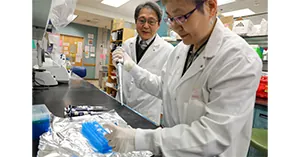
Groundbreaking Gene Therapy Research Offers New Prospects for Chronic Kidney Disease Patients
2024-12-30
Author: Ming
Introduction
Exciting developments in gene therapy targeting chronic kidney disease (CKD) could revolutionize treatment options for millions affected by this debilitating condition. Researchers at Oregon Health & Science University (OHSU) have shown significant progress in utilizing adeno-associated virus (AAV) vectors, specifically designed to improve gene delivery directly to kidney cells.
Challenges in Traditional Gene Delivery
Historically, effective delivery of gene therapies to the kidneys has been fraught with challenges. Traditional AAV capsids, which serve as protein shells for transporting therapeutic genes, have shown varying levels of efficacy depending on how they are administered. Most commonly delivered via intravenous (IV) injection, these methods often fail to adequately target kidney cells and can inadvertently lead to detrimental side effects, particularly affecting the liver.
Innovative Strategies for Gene Delivery
However, the recent study published in Nature Communications reveals innovative strategies to enhance gene delivery to the kidneys. Researchers experimented with 47 distinct AAV capsids, utilizing various injection methods, including direct injections into the renal vein or pelvis—areas much closer to the kidneys. This surge of targeted approaches has demonstrated promising results in maximizing the efficiency of gene transfer.
Discovery of AAV-KP1 Capsid
Dr. Hiroyuki Nakai, a leading figure in the study, along with his team, found that one specific capsid, AAV-KP1, excelled when injected directly to the kidneys, successfully reaching renal cells while minimizing liver impact. In contrast, AAV9, traditionally viewed as ineffective for healthy kidneys, performed better in patients with CKD under IV injection. This groundbreaking realization shifts the paradigm, suggesting localized delivery may be the key to advancing the efficacy of kidney-targeted therapies.
Genetic Kidney Diseases in Adults
As genetic kidney diseases were once thought to predominantly affect children, emerging research highlights the genetic underpinnings also prevalent in adults with chronic renal issues. Dr. Taisuke Furusho, the study's lead author, emphasizes the complexity of the kidney's structure—comprised of various cell types—as a significant hurdle in effective gene therapy.
Differences Between Species
Another fascinating aspect of the study revealed that the behavior of AAV capsids can differ markedly between species. While mice served as initial testing subjects, the research underscored the differences observed in nonhuman primates, specifically in how these vectors penetrated renal cells. This variation highlights the importance of species selection in designing and executing gene therapies.
Broader Applications of Gene Therapy
These promising advancements in AAV technology not only provide hope for more targeted kidney disease treatments but also shed light on broader applications of gene therapy in both pediatric and adult patient populations. With the potential to rectify gene expression, there remains immense promise for improving outcomes for those grappling with genetic causes of chronic kidney disease.
Conclusion
This research opens new avenues for further investigation into optimizing gene delivery systems and crafting tailored therapies that address the unique challenges presented by kidney diseases. The team's findings underscore the importance of not just the genetic material being delivered but the tailored method of administration, signaling a pivotal shift in the future of kidney disease treatment.
In summary, as researchers like Dr. Nakai continue to unveil the intricacies of AAV-based gene therapies, the prospects for effectively combating chronic kidney disease grow brighter, bringing newfound hope for improved patient care and therapeutic strategies.
 Brasil (PT)
Brasil (PT)
 Canada (EN)
Canada (EN)
 Chile (ES)
Chile (ES)
 Česko (CS)
Česko (CS)
 대한민국 (KO)
대한민국 (KO)
 España (ES)
España (ES)
 France (FR)
France (FR)
 Hong Kong (EN)
Hong Kong (EN)
 Italia (IT)
Italia (IT)
 日本 (JA)
日本 (JA)
 Magyarország (HU)
Magyarország (HU)
 Norge (NO)
Norge (NO)
 Polska (PL)
Polska (PL)
 Schweiz (DE)
Schweiz (DE)
 Singapore (EN)
Singapore (EN)
 Sverige (SV)
Sverige (SV)
 Suomi (FI)
Suomi (FI)
 Türkiye (TR)
Türkiye (TR)
 الإمارات العربية المتحدة (AR)
الإمارات العربية المتحدة (AR)